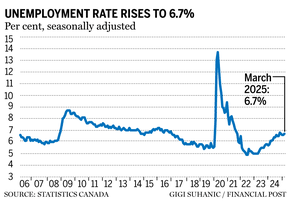Financial Insights That Matter
Largest decrease in employment since January 2022

Article content
Canada’s unemployment rate climbed to 6.7 per cent in March, up from 6.6 per cent the month before, as the economy lost 33,000 jobs, Statistics Canada said on Friday.
Article content
Article content
The job losses were the largest decrease in employment since January 2022. Economists polled by Reuters had expected a gain of 10,000 jobs in the month.
Nearly 1.5 million people were unemployed in March, up 36,000 from the previous month and 167,000 from a year ago. Employment fell in the wholesale and retail trade, information, culture and recreation, agriculture, manufacturing and construction sectors.
Advertisement 2
Article content
“The wheels may be starting to fall off the Canadian labour market, with a 33,000 decline in jobs during March falling well short of consensus forecasts for a 10,000 gain,” Andrew Grantham, an economist at CIBC Capital Markets, said in a note after the data was released.

Private-sector employment fell by 48,000 in March, while public-sector employment was little changed. The overall drop in employment was driven by a 0.4 per cent decline in full-time work.
“The impact of trade tariffs appears to be working its way through the economy,” James Orlando, senior economist at Toronto-Dominion Bank, said in a note to clients. “Businesses and consumers are naturally hesitant in the face of heightened political uncertainty.”
Last month, when the Bank of Canada cut its interest rate to 2.75 per cent, it posted findings from business and consumer surveys that showed businesses plan to pull back on hiring amid trade uncertainty with the United States.
In early March, U.S. President Donald Trump imposed a 25 per cent tariff on Canadian goods not in compliance with the Canada-United States-Mexico Agreement (CUSMA) and a 10 per cent tariff on Canadian energy not in compliance with CUSMA. He also imposed a 25 per cent tariff on Canadian steel and aluminum on March 12 and on autos not made in the U.S. on April 3.
Article content
Advertisement 3
Article content
“As a result of all these trade-related factors, many businesses have scaled back their hiring and investment plans,” Bank of Canada governor Tiff Macklem said during the bank’s last policy rate announcement on March 12.
Statistics Canada on Friday said 0.7 per cent of those who were employed in February became unemployed in March due to layoffs. The layoff rate is little changed from what it was a year ago and is identical to the pre-pandemic average.

“Gauging the contribution of swirling tariff winds is the key question in the soft March numbers, but we didn’t see the smoking gun,” Brendon Bernard, senior economist at Indeed Canada, said in a note. “Instead, March’s weakness stemmed from a continuation of the trends that weighed on the job market in 2024, namely, slow hiring, which has made it tougher for those out of work to land a job.”
The weak jobs report could give the Bank of Canada room to cut its rate at its next decision on April 16, economists said.
“While pricing for April is still undecided, we think the bank should keep cutting by at least another 50 basis points (cumulative) over the coming months in order to cushion the blow from tariffs,” Orlando said. “Today’s discouraging jobs report showcases the downside risks to the economy, which warrants further action from the Bank of Canada.”
Advertisement 4
Article content
Grantham said the job market is expected to continue to decline, especially in sectors most directly impacted by U.S. tariffs. CIBC expects the unemployment rate to peak slightly above seven per cent in the second half of this year.
The Bank of Canada’s business and consumer outlook survey out Monday will also be key to the central bank’s next rate decision, he said.
Total hours worked rose by 0.4 per cent during the month and 1.2 per cent from a year ago. Average hourly wages were up 3.6 per cent on a year-over-year basis, following 3.8 per cent growth in February.
Recommended from Editorial
-

Tariffs could lead to 160,000 job losses in second quarter
-

Who is Canada’s middle class
• Email: [email protected]
Bookmark our website and support our journalism: Don’t miss the business news you need to know — add financialpost.com to your bookmarks and sign up for our newsletters here.
Article content
#1a73e8;">Boost Your Financial Knowledge and Achieve Stability
Discover a growing online community dedicated to delivering financial news, tips, and strategies designed to help you manage money effectively, save smarter, and grow your investments with confidence.
#1a73e8;">Top Financial Tips for Saving and Investing
- Personal Finance Management: Master the art of budgeting, expense tracking, and building a strong financial foundation.
- Investment Opportunities: Stay updated on market trends, learn about stocks, and explore secure ways to grow your wealth.
- Expert Money-Saving Advice: Access proven techniques to reduce expenses and maximize your financial potential.




Comments